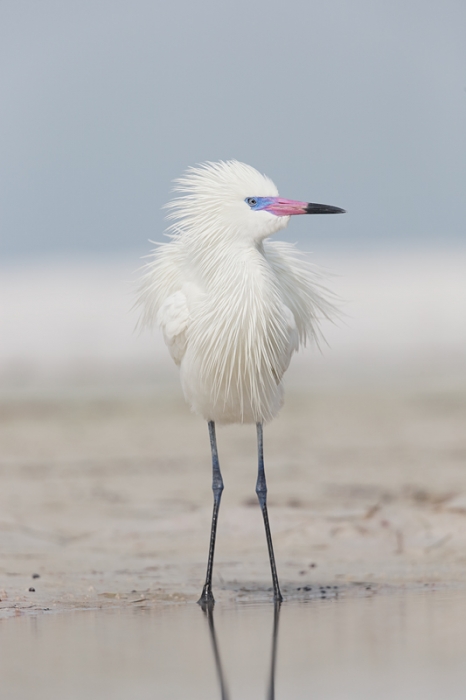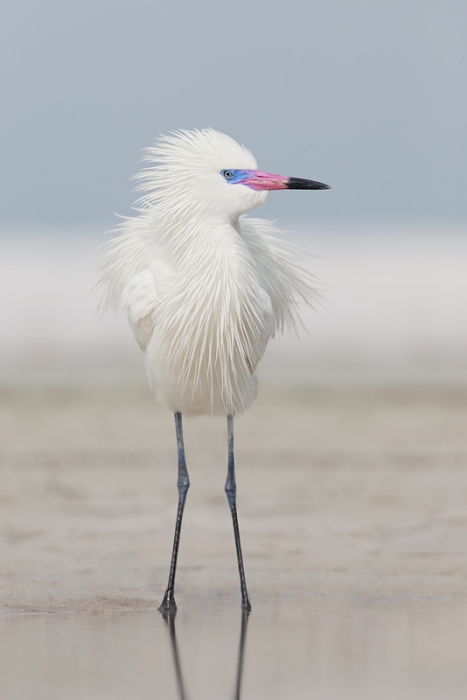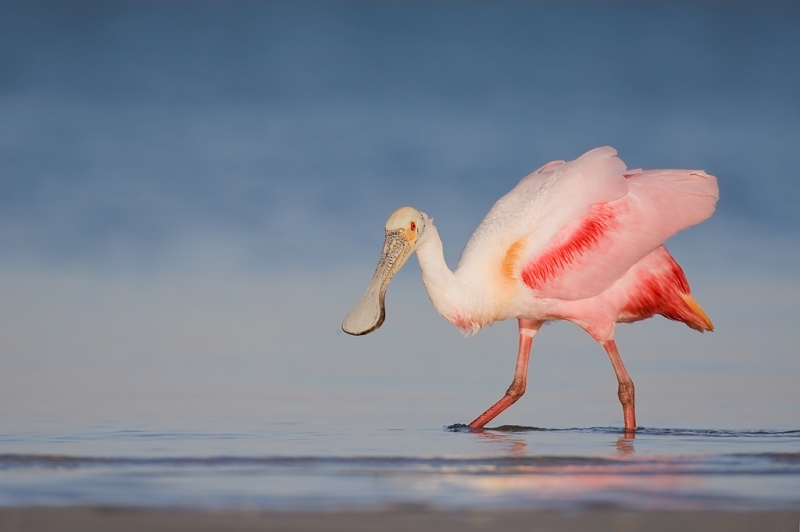Exposure Quiz
Those who missed the One Second to Act Exposure Quiz blog post are invited to click here and see how smart they are. I will let you know what I did and address the comments tomorrow so best not to tarry.
|
This is the original image from which I created the optimized file below. It was created on the Fort DeSoto In-the-Field Workshop on Monday morning past with the tripod-mounted Canon 500mm f/4L EF IS II USM lens, the Canon 1.4x EF Extender III (Teleconverter), and the Canon EOS-1D X digital SLR camera body. ISO 400. Evaluative metering +1/3 stop as framed: 1/2000 sec. at f/6.3 in Manual mode confirmed by histogram check. Three up from the central sensor/AI Servo Surround/Rear Focus AF active at the moment of exposure. Click here if you missed the Rear Focus Tutorial. Click on the image to see a larger version. |
Pinky Clean-up
For whatever reason, I have, over the years, taken to calling beautiful white morphs Reddish Egrets “pinkies.” I guess that it is not too hard to figure out why.
When I was first alerted to the presence of this bird and got into position I saw immediately that the background was pretty gross. Even getting down flat on the ground did not help a great deal.
To create the optimized image below I began by leveling it, doing some Eye Doctor work–can you see what I did there?, and flopping a large Quick Mask of the left side of the frame to cover the mess on our right. For the rest of the clean-up I relied on a technique that Denise Ippolito taught me, “Cloning on a Layer.” You create a new layer with the whole image on it, clone with impunity even if you clone over the subject, and then add a Regular Layer Mask and paint the subject back in where needed. I finished with a 25% layer of Detail Extractor and Tonal Contrast on the bill with NIK’s Color Efex Pro.
All of the above is detailed in our Digital Basics file. Digital Basics includes my complete digital workflow, dozens of great Photoshop tips, Layer Masking for Dummies, Eye Doctor work, NIK Color Efex Pro basics, all of my Keyboard Shortcuts, and tons more. This PDF, sent via e-mail, will be the best $25 you’ll ever spent on your photography. Your purchase includes free updates.Learn advanced Quick Masking techniques in APTATS I. Learn advanced Layer Masking Techniques in APTATS II.
|
This image of a stunning white morph Reddish Egret in full breeding plumage was created on the Fort DeSoto In-the-Field Workshop on Monday morning past with the tripod-mounted Canon 500mm f/4L EF IS II USM lens, the Canon 1.4x EF Extender III (Teleconverter), and the Canon EOS-1D X digital SLR camera body. ISO 400. Evaluative metering +1/3 stop as framed: 1/2000 sec. at f/6.3 in Manual mode confirmed by histogram check. Three up from the central sensor/AI Servo Surround/Rear Focus AF active at the moment of exposure. Click here if you missed the Rear Focus Tutorial. Click on the image to see a larger version. Kudos to co-leader Denise Ippolito for pointing this bird out to the group; most folks were paying rapt attention to either the flock of tame Royal Terns or the beautiful female Long-billed Curlew. |
MP4 Photoshop Tutorial Videos
See and hear me at work in Photoshop in these great MP4 instructional videos. Cheap! You can see them all and learn more here and learn about our latest offering here.
| [Not a valid template] |
NIK 15% Discount
A 30% layer of Detail Extractor and Tonal Contrast fine-tuned via a Regular Layer Mask really brought this image to life. As regular readers know, Color Efex Pro has drastically changed my digital workflow and little by little I have begun using Viveza to solve sticky image optimization problems and Silver Efex Pro fo fast, dramatic B&W conversions. You can save 15% on all NIK products (including Color Efex Pro, Silver Efex Pro, and Viveza) by clicking here and entering BAA in the Promo Code box at check-out. Then hit Apply to see your savings. You can download a trial copy that will work for 15 days and allow you to create full sized images.
Fort DeSoto/Hooptie Deux/Roseate Spoonbill Short Notice IPT
|
This Roseate Spoonbill was photographed last year at Alafia Banks with the tripod-mounted Canon EF 800mm f/5.6L IS USM Autofocus lens and the Canon EOS-1D Mark IV now replaced by the Canon EOS-1D X digital SLR . ISO 500. Evaluative metering +2/3 stop as framed: 1/1250 sec. at f/7.1 in Manual mode in early morning light. The very best opportunities in Florida to photograph this species in breeding plumage are with Captain James Shadle on the Hooptie Deux. |
Fort DeSoto/Hooptie Deux/Roseate Spoonbill Short Notice IPT: March 6-10, 2013. 5-DAY: $2399 (Includes 3 mornings on the Hooptie Deux). Limit: 6/Openings: 4.
Join me as part of a small group for five great days of bird photography and learning. We will spend three mornings with the breeding plumage spoonbills on James Shadle’s customized pontoon boat. This alone would cost you $1050 so this works out to the cheapest IPT ever: 5 full days for only $1349. We will spend two of our mornings and four of our afternoons at Fort DeSoto photographing all manner of wading birds, gulls, terns, and almost surely some Great Horned Owl chicks. Our last afternoon will be spent at an active Wood Stork rookery with lots of flight photography opportunities.
Click here and scroll down for additional details on this New Concept IPT.
Seriously Huge B&H Savings on Nikon and Canon Gear
Nikon
For the first time in many years NIKON is going to be deeply discounting many legacy pro lenses individually for the next 2 weeks only with discounts up to $350. There are also many amazing deals on NIKON Buy together and Save packages as well. Click here to save.
Nikon DSLRS Bundles with Lenses & Flash: Save up to $750. Click here to save. Make sure to add each item to your shopping cart to see the absolute lowest price.
Canon Lenses & Speedlites: Save Up to $300
Click here to save. Make sure to add each item to your shopping cart to see the absolute lowest price.
Canon Buy Together & Save: Save Up to $400
Click here to save.
EOS-1D X AF Guide
You can learn exactly how I set up and use this camera’s great new AF system in our EOS-1D X AF Guide. And you can learn about our other camera User’s Guides here.
Southwest Florida Site Guide
Several folks have written recently asking why this great guide has not been updated since 2007. The answer is that I have not discovered any new hotspots and that the good places remain good and the great places remain great. We found the Snowy Plovers on Wednesday in the exact spot described in the Southwest Florida Site Guide. Go figure.
Typos
On all blog posts, feel free to e-mail or leave a comment regarding any typos, wrong words, misspellings, omissions, or grammatical errors. Just be right. 🙂
Support the BAA Blog. Support the BAA Bulletins: Shop B&H here!
We want and need to keep providing you with the latest free information, photography and Photoshop lessons, and all manner of related information. Show your appreciation by making your purchases immediately after clicking on any of our B&H or Amazon Affiliate links in this blog post. Remember, B&H ain’t just photography!
Support the BAA Blog. Support the BAA Bulletins: Shop Amazon here!
And from the BAA On-line Store:
LensCoats. I have a LensCoat on each of my big lenses to protect them from nicks and thus increase their re-sales value. All my big lens LensCoat stuff is in Hardwood Snow pattern.
LegCoat Tripod Leg Covers. I have four tripods active and each has a Hardwood Snow LegCoat on it to help prevent further damage to my tender shoulders :) And you will love them in mega-cold weather....
Gitzo GT3532 LS CF Tripod. This one replaces the GT3530LS Tripod and will last you a lifetime. Learn more about this great tripod here.
Mongoose M3.6 Tripod Head. Right now this is the best tripod head around for use with lenses that weigh less than 9 pounds. For heavier lenses, check out the Wimberley V2 head.
Double Bubble Level. You will find one in my camera's hot shoe whenever I am not using flash.
The Lens Align Mark II. I use the Lens Align Mark II pretty much religiously to micro-adjust all of my gear an average of once a month and always before a major trip. Enjoy our free comprehensive tutorial here.
BreezeBrowser. I do not see how any digital photographer can exist without this program.
Delkin Flash Cards. I use and depend on Delkin compact Flash Cards and card readers most every day. Learn more about their great 700X and 1000X cards here or about my favorite Delkin card here.

















Hi Art! Just a quick question…a curiosity more than anything else. In the cleaned-up version of the Egret, it appears as though you also removed the shadow behind the right leg. Personally, I kind of liked the depth that added, and while I think cleaning up the rest of the “junk” definitely improves the photo…I guess I kind of miss the shadow.
What exactly are your thoughts behind shadows? Like em? Hate em? If so, why? (I ask, as I’ve seen similar edits on BPN, sometimes with the bird’s shadow, sometimes with shadows from other objects. Shadow removal always seems a little obvious, and ends up removing subtle but I think necessary elements of depth from a scene, giving it what feels like an artificially flat look.)
Hi Jon, I am not seeing even a hint of a shadow in the original…. In general I might try to lighten an obtrusive shadow or remove the blue cast after the fact. Of course, in most cases I work right on or close to sun angle; this reduces the size of the shadow and places it directly behind or under the bird. In a few cases an angled shadow can add to a compostion if you choose your perspective and framing carefully.
Where are you seeong a shadow? (I am mystified :))
The shadow is not large, it is small, and soft…the way I figure a bird’s shadow in a good photograph should be. As for location…it is in the sand, almost directly under and slightly behind the bird, right behind the Egret’s right-hand leg, just where the sand and the water meet. The sand there in the original is darker…grayish. I am quite sure it is a shadow given the angle of the sun, and the shadows the bird is casting on itself.
In the cleaned up version, that dark area is gone. There is still a very slight hint of very minimally darker sand in the clean version, but the shadow itself, which seemed to be in the right place, is gone.
You have much better eyes than me. I have looked long and hard at the original and see no hint of a shadow….
Original, yellow arrow showing what I think is generally the angle of the sun, and the dark spot behind the bird that I believe is it’s shadow:
http://i.imgur.com/cOrpMUQ.jpg
The cleaned up image, where the shadow seems to be missing:
http://i.imgur.com/T3xKSnV.jpg
Maybe you just consider the dark sand behind the birds leg to be something else?
Ah, my last comment did not post. I did finally see the faint shadow in the original. A I barely noticed it I am not going to lose any sleep about losing it :).
Oh, I see your last comment now…looks like it went to the other comment chain. Yeah, I know your not losing sleep. 😛 I was just curious what your thoughts in general were about shadows. I see a lot of people editing them out. I can understand that in some ways…harsh hard-edged shadows from other scene elements can be distracting. When it comes to the shadow of the subject itself, I feel it adds a useful sense of depth, but they seem to be edited out fairly often. Was curious why.
What you are calling a white morph ….is in actuality a Leucistic Reddish Egret ….that is the proper terminology . I was there too and captured many wonderful images following her for two days . Leucisim is a quite specific abberation in coloration . Just FYI .
Hi Francoise. Lucky you. But you are 100% wrong in this case. See same in Sibley or just about any other decent reference. Morph or form if you wish but surely not leucistic.
Well, I finally see what you are talking about. It could be the shadow, it could be wet sand. IAC, it does not concern me at all either way.